The AMD 3rd Gen Ryzen Deep Dive Review: 3700X and 3900X Raising The Bar
by Andrei Frumusanu & Gavin Bonshor on July 7, 2019 9:00 AM EST** = Old results marked were performed with the original BIOS & boost behaviour as published on 7/7.
Benchmarking Performance: CPU System Tests
Our System Test section focuses significantly on real-world testing, user experience, with a slight nod to throughput. In this section we cover application loading time, image processing, simple scientific physics, emulation, neural simulation, optimized compute, and 3D model development, with a combination of readily available and custom software. For some of these tests, the bigger suites such as PCMark do cover them (we publish those values in our office section), although multiple perspectives is always beneficial. In all our tests we will explain in-depth what is being tested, and how we are testing.
All of our benchmark results can also be found in our benchmark engine, Bench.
Application Load: GIMP 2.10.4
One of the most important aspects about user experience and workflow is how fast does a system respond. A good test of this is to see how long it takes for an application to load. Most applications these days, when on an SSD, load fairly instantly, however some office tools require asset pre-loading before being available. Most operating systems employ caching as well, so when certain software is loaded repeatedly (web browser, office tools), then can be initialized much quicker.
In our last suite, we tested how long it took to load a large PDF in Adobe Acrobat. Unfortunately this test was a nightmare to program for, and didn’t transfer over to Win10 RS3 easily. In the meantime we discovered an application that can automate this test, and we put it up against GIMP, a popular free open-source online photo editing tool, and the major alternative to Adobe Photoshop. We set it to load a large 50MB design template, and perform the load 10 times with 10 seconds in-between each. Due to caching, the first 3-5 results are often slower than the rest, and time to cache can be inconsistent, we take the average of the last five results to show CPU processing on cached loading.
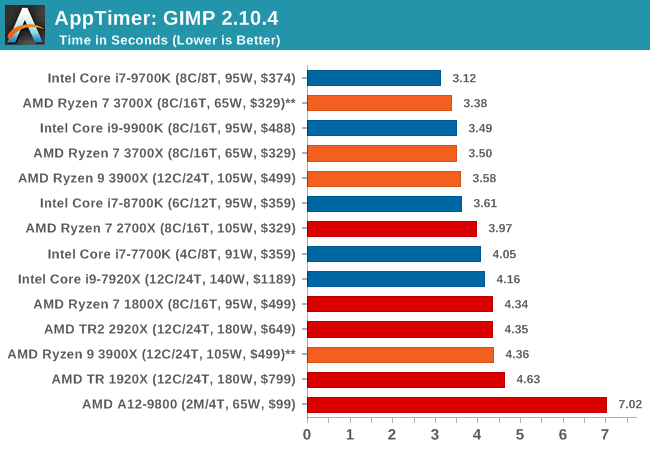
Application loading is typically single thread limited, but we see here that at some point it also becomes core-resource limited. Having access to more resources per thread in a non-HT environment helps the 8C/8T and 6C/6T processors get ahead of both of the 5.0 GHz parts in our testing.
3D Particle Movement v2.1: Brownian Motion
Our 3DPM test is a custom built benchmark designed to simulate six different particle movement algorithms of points in a 3D space. The algorithms were developed as part of my PhD., and while ultimately perform best on a GPU, provide a good idea on how instruction streams are interpreted by different microarchitectures.
A key part of the algorithms is the random number generation – we use relatively fast generation which ends up implementing dependency chains in the code. The upgrade over the naïve first version of this code solved for false sharing in the caches, a major bottleneck. We are also looking at AVX2 and AVX512 versions of this benchmark for future reviews.
For this test, we run a stock particle set over the six algorithms for 20 seconds apiece, with 10 second pauses, and report the total rate of particle movement, in millions of operations (movements) per second. We have a non-AVX version and an AVX version, with the latter implementing AVX512 and AVX2 where possible.
3DPM v2.1 can be downloaded from our server: 3DPMv2.1.rar (13.0 MB)
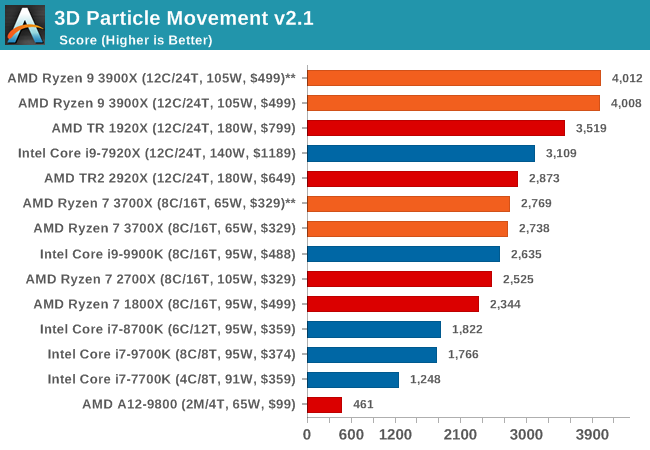
With a non-AVX code base, the 9900K shows the IPC and frequency improvements over the R7 2700X, although in reality it is not as big of a percentage jump as you might imagine. The processors without HT get pushed back a bit here.

Dolphin 5.0: Console Emulation
One of the popular requested tests in our suite is to do with console emulation. Being able to pick up a game from an older system and run it as expected depends on the overhead of the emulator: it takes a significantly more powerful x86 system to be able to accurately emulate an older non-x86 console, especially if code for that console was made to abuse certain physical bugs in the hardware.
For our test, we use the popular Dolphin emulation software, and run a compute project through it to determine how close to a standard console system our processors can emulate. In this test, a Nintendo Wii would take around 1050 seconds.
The latest version of Dolphin can be downloaded from https://dolphin-emu.org/
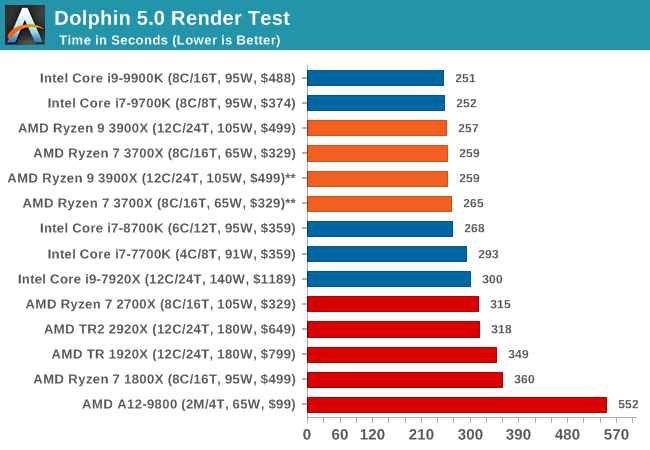
DigiCortex 1.20: Sea Slug Brain Simulation
This benchmark was originally designed for simulation and visualization of neuron and synapse activity, as is commonly found in the brain. The software comes with a variety of benchmark modes, and we take the small benchmark which runs a 32k neuron / 1.8B synapse simulation, equivalent to a Sea Slug.
Example of a 2.1B neuron simulation
We report the results as the ability to simulate the data as a fraction of real-time, so anything above a ‘one’ is suitable for real-time work. Out of the two modes, a ‘non-firing’ mode which is DRAM heavy and a ‘firing’ mode which has CPU work, we choose the latter. Despite this, the benchmark is still affected by DRAM speed a fair amount.
DigiCortex can be downloaded from http://www.digicortex.net/
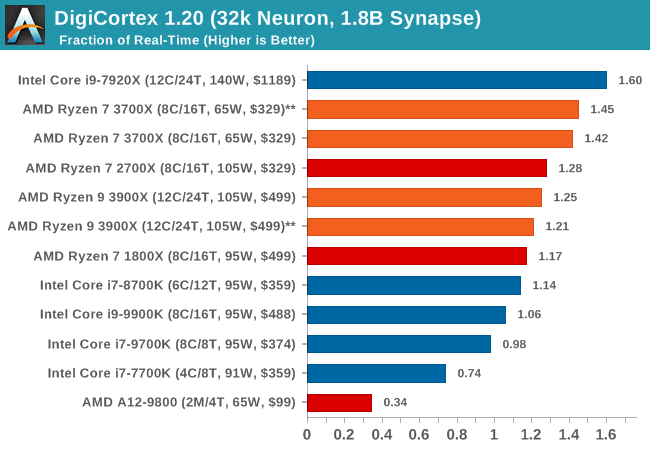
y-Cruncher v0.7.6: Microarchitecture Optimized Compute
I’ve known about y-Cruncher for a while, as a tool to help compute various mathematical constants, but it wasn’t until I began talking with its developer, Alex Yee, a researcher from NWU and now software optimization developer, that I realized that he has optimized the software like crazy to get the best performance. Naturally, any simulation that can take 20+ days can benefit from a 1% performance increase! Alex started y-cruncher as a high-school project, but it is now at a state where Alex is keeping it up to date to take advantage of the latest instruction sets before they are even made available in hardware.
For our test we run y-cruncher v0.7.6 through all the different optimized variants of the binary, single threaded and multi-threaded, including the AVX-512 optimized binaries. The test is to calculate 250m digits of Pi, and we use the single threaded and multi-threaded versions of this test.
Users can download y-cruncher from Alex’s website: http://www.numberworld.org/y-cruncher/

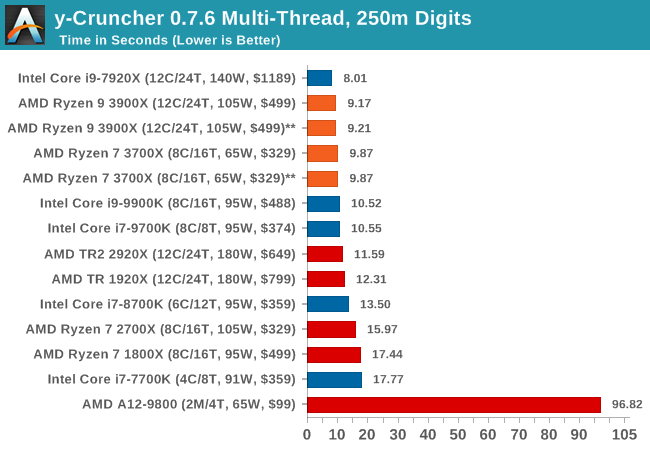
Agisoft Photoscan 1.3.3: 2D Image to 3D Model Conversion
One of the ISVs that we have worked with for a number of years is Agisoft, who develop software called PhotoScan that transforms a number of 2D images into a 3D model. This is an important tool in model development and archiving, and relies on a number of single threaded and multi-threaded algorithms to go from one side of the computation to the other.
In our test, we use version 1.3.3 of the software with a good sized data set of 84 x 18 megapixel photos, and push it through a reasonably fast variant of the algorithms. We report the total time to complete the process.
Agisoft’s Photoscan website can be found here: http://www.agisoft.com/
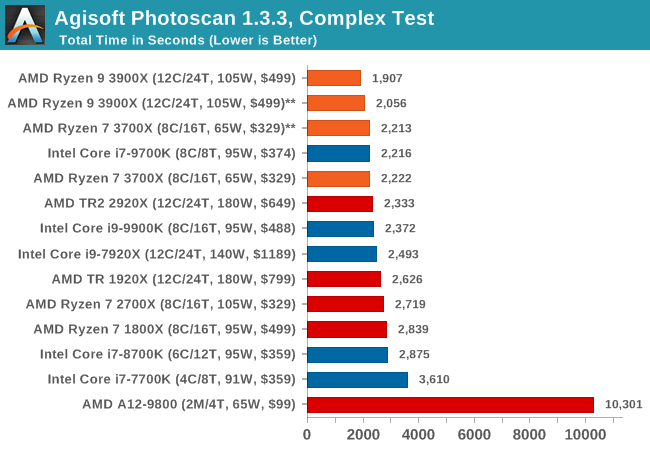












447 Comments
View All Comments
Korguz - Monday, July 22, 2019 - link
Maxiking, and HOW LONG till intel gets the SAME treatment?? saying a processor uses x watts, but in reality uses 50 to 100 watts MORE isnt FRAUD ??? hell you confine intels cpus to the watts they state, and their performance goes DOWN THE TOILET !!!. again .. you KEEP saying AMD is a fraud, but you STILL refuse to admit, that intel is a fraud as well..does this guy even acknowlege the issue with intel and the amount of power they " say " their cpus use, and how much power they REALLY use ??
Korguz - Monday, July 22, 2019 - link
further.. intel doesnt do any marketing, cause they DON'T want the general average user to know the cpu they bought, uses MORE power then has been stated, THAT also is false advertising, come on maxiking, go after intel as well, the same same things you are accusing amd of...Maxiking - Tuesday, July 23, 2019 - link
You are uneducated, TDP doesn't mean power consumption but the amount of heat dissipated, it informs you how much of heat the cooler must be able to dissipate in order to keep the cpu cool enough to run.Get it? 1700x TDP was 95W yet there were tasks it managed to consume 120 or even 140w on stock settings. Like do you even watch reviews? It was the same with 2700w.
but mimimimimimi AMD good mimimimimi Intel bad
Korguz - Tuesday, July 23, 2019 - link
sorry dude.. but YOU are uneducated, amd stays A LOT closer to its stated TDP then intel does, AT even did a review on it. power dissipated, also relates to power used. but it also doesnt help, that amd and intel both use the term TDP differently. either way.. intel uses more power then amd does.https://www.anandtech.com/show/13544/why-intel-pro...
Maxiking - Tuesday, July 23, 2019 - link
Again, TDP is not power consumption and it refers to a cooler.You are uneducated and fabricating because you are an amd fanboy. No one really cares about what is more accurate or not, because it does not say anything about power consumption of the chip.
So keep living in your nice little bubble. It is not my fault that you and other sites have been thinking that TDP -> power consumption. I will share something new to you again.. Ever heard about that Frankenstein novel? Frankenstein in not the monster but the doctor, his surname..Shocking I KNOW!!!
mimimimimimi AMD good mimimimimi Intel bad
Korguz - Tuesday, July 23, 2019 - link
again.. TDP, or Thermal Design Power, does relate to power consumption and how much is needed to keep something cool. You are uneducated and fabricating because you are an intel fanboy. i also notice you like to throw personal insults around when someone disagrees with you, or to try to make your opinion valid. so you keep living in your nice little bubble as well, not my fault you dont understand TDP relates to how much power something uses, as the more power a product uses, the more heat it creates, and then, needs to be removed.mimimimimimi intel good mimimimimi amd bad
Maxiking - Thursday, July 25, 2019 - link
What you just did it is just sad. it shows you are little kid.TDP is not power consumption, if TDP - 100% power consumption, it would mean that 100% of the electrical energy is converted into thermal energy so yeah which is impossible it would mean perpetuum mobile you twat, actually the cpu would be net positive, it would convert 100% of electrical energy into thermal whilst managing to perform another task at no energy cost.
Breaking the laws of physics just because of your AMD fanboyism
Korguz - Thursday, July 25, 2019 - link
i said it RELATES to power consumption, what, you cant read ?? cant see passed your intel bias ?? the more power something uses, the more heat it generates, and there for, the more needs to be dissipated, and i also never said anything about 100% power consumption, pulling words and making things up to try to make your self sound right ? And you are calling me names on top of that, who's the kid here ???Maxiking - Tuesday, July 23, 2019 - link
You are uneducated, TDP doesn't mean power consumption but the amount of heat dissipated, it informs you how much of heat the cooler must be able to dissipate in order to keep the cpu cool enough to run.Get it? 1700x TDP was 95W yet there were tasks it managed to consume 120 or even 140w on stock settings. Like do you even watch reviews? It was the same with 2700w.
but mimimimimimi AMD good mimimimimi Intel bad
Qasar - Tuesday, July 23, 2019 - link
hmmm doest really say amd is being fraudulent, just doesnt like the idea the chips might not boost, or run at what AMD says, but didnt mention fraud...and Korguz has a point.. WHY arent you commenting about the power intels cpus use, vs what intel says they use ?